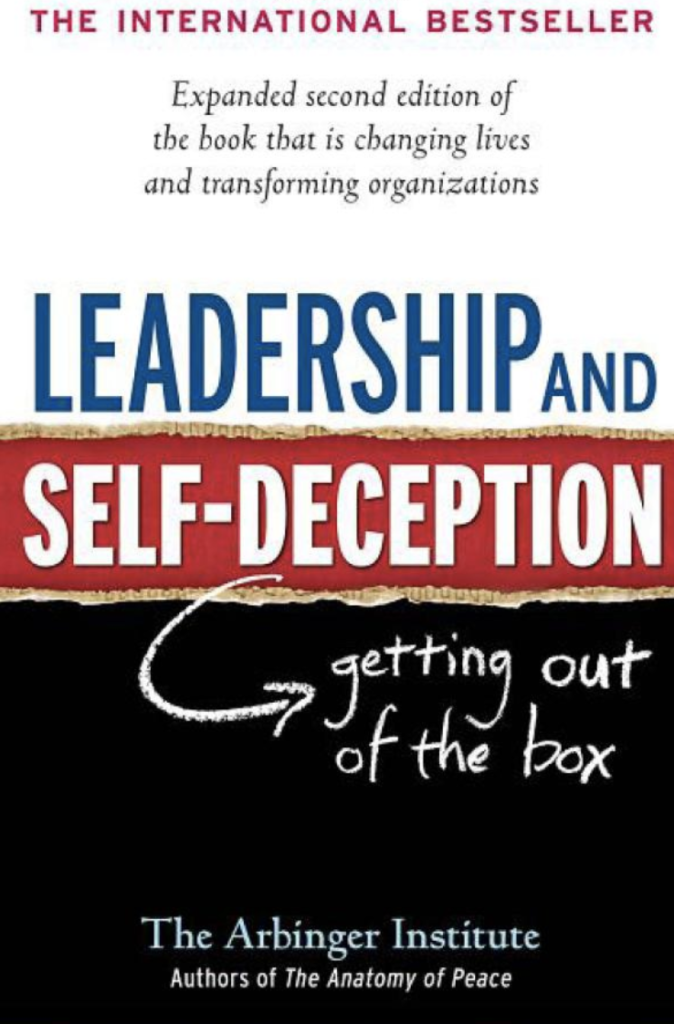BOOK FACTS
- Title: “Leadership and Self-Deception: Getting Out of the Box”
- Author: The Arbinger Institute
- Publisher: Berrett-Koehler Publishers, Inc., Oakland, CA
- Copyright: 2000, 2010, 2018
- No. of Pages: 221
- No. of Chapters: 24
RATING (5 IS A MUST READ – 1 IS LOW INTEREST IN READING)
Readability: 5
Maintains Attention: 5
Applicability of Information: 5
REVIEW
“Leadership and Self-Deception” is one of the best books I’ve read. I’m convinced if you decide to read this book and truly consider and apply the concepts, this book will be life-changing.
The book is written in a story format and centers on a character by the name of Tom. The company leaders decided it was time for Tom to experience a coaching process which had a profound impact on the organization’s other employees. It’s through this coaching journey that we learn the main theme of the book which is how to live life outside of the box. Although this is a simple concept to understand as you read the book, you will also find that it is amazingly complex and challenging at the same time.
Whether you’re a leader with a title, power, and position, or a leader by influence and persuasion, this book is for you. I believe this book is meant for anyone who desires to change how they interact with people around them to foster healthier, more productive, and more meaningful relationships.
SUMMARY OF MAIN POINTS
“Leadership and Self-Deception” is broken into three parts. Part one describes the concept of “being in the box.” It walks through the fictional story of Tom, an executive for Zagrum Company. Tom is new to the company and seems to be experiencing difficulty being an effective leader. Part one sets the back story regarding Tom, the other characters, and the culture and history of Zagrum Company. It also shares the core concept of “being in the box” and what this looks like in our daily lives. The main point explains how being focused on our own wants and needs creates substantial relationship challenges.
Part two discusses how we get into the box. It focuses on the fundamental concept of self-betrayal. As we learn about self-betrayal, we learn how quickly our daily interactions can cause us to become self-focused.
Part three explores how we can get out of the box, but as Tom realizes; this isn’t so easy. We tend to look to books and other resources for a step-by-step process to address such challenges. Tom soon discovers that no such book exists and that everybody’s quest is different.
As the book concludes, we are left with an amazing opportunity to challenge ourselves in becoming a person who lives “outside of the box.” One of the most powerful statements in the book is found in the appendix. The statement is simply this, “As far as I’m concerned, the problem is me.”
CALL TO ACTION
After reading this book, there are numerous principles, concepts, and actions to support leaders in exploring and developing a better understanding of themselves and how to build healthier and more effective relationships. The following are a few actions that you can consider doing right now:
- Apply the concept of “being in the box” to your interactions to better understand how what you do and say affect not only your life, but the lives of others.
- Apply the concept of living “out of the box” to determine where changes need to be made.
- When interacting with people, especially with difficult interactions, remember that the other person has wants, needs, hopes, and dreams just like you. Will you concentrate your time and energy on meeting your own needs, or will you focus on others?
- Consider how your life and your relationships might change if your first thought was “As far as I’m concerned, the problem is me.”


